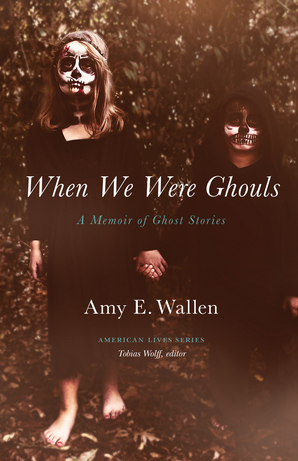Reviewed by April Line
 The slow, marked, deliberate pace of this memoir is a gift. Amy Wallen’s When We Were Ghouls (University of Nebraska Press, March 2018) is worth every word. Wallen’s sharp memories of her childhood are arresting in their simplicity. Her voice is at once innocent, searching, and wizened, cautious, anxious.
The slow, marked, deliberate pace of this memoir is a gift. Amy Wallen’s When We Were Ghouls (University of Nebraska Press, March 2018) is worth every word. Wallen’s sharp memories of her childhood are arresting in their simplicity. Her voice is at once innocent, searching, and wizened, cautious, anxious.
While the essays are all on the short side—three-to-fifteen pages—they are rich in their tangibly pointed images and perfectly attested emotionality. Warren is worried about being deserted. First, she is left intermittently by her father, then by her older siblings who attend boarding school, then by her mother who contracts malaria and is unwell for some time, and finally, though her father’s work is to blame, her sense of instability is exacerbated by moving from homes in the U.S., Nigeria, Peru, and Bolivia. Each home has its own cast of characters, its own tangible symbols of Wallen’s aloneness and curiosity.
Though this work professes to be a gothic memoir, the ghoulishness is softcore. Images of ghouls appear as whispers, repeated images—a skull in the pantry—and the part of her father’s life she’ll never fully know: was he FDA? CIA? Shades of shared stories are told and retold, by her father, her mother, herself, and perceptions of her two older siblings mixed in. The pet parrot named Pretty Bird joined her under semi-haunted circumstances, after a particularly stressful time with a “housekeeper” named Juana, who was a black witch, who, Wallen was convinced, had cursed her.
The version of Wallen who lives in these pages wants to be an adult. She wants to be safe from abandonment. She finds surety in the unsure, her mother the most consistent figure in her life, her parrot next most. She loves her brother, worships him perhaps. But he is only home for the winter holidays.
These stories, set in the 70s, are interwoven with recollections of Wallen’s interactions with her parents in the present and telephone conversations with her father where she holds her breath and tongue to see if he will reveal pieces of his secret past. Email exchanges with her mother, in which Mrs. Wallen confesses in a sideways fashion, subjecting Wallen to what might be considered emotional neglect.
Throughout, there’s a sense of being untethered. Wallen is not tied to a contiguous reality, her mother—game, along for the ride—is intermittently absent for both social and health reasons, and it seems to be her presence Wallen both yearns for and most fears losing. This is a portrait, again and again, of a floating adolescent: a sensitive, observant, clever daughter in a world of unfamiliar geography, a possibly undercover father and, once and again, vivid, focused images of things, places, and moods.
Wallen’s childhood is familiar to those of us who were sensitive, solitary children. Despite her international digs, her instincts and memories are homey narratives, full of the pathos and neurosis of a coming-of-age tale. Regardless of how true or untrue the stories are, Wallen grapples with what memories mean, how much of them may be trusted, where hers begin and her family’s end. Her childhood is that of a writer, an observer, a layer-in-wait, a sieve, an oracle of what surrounds her, tangibly and otherwise. Her observations, perfect in their purity, not without the weight of meaning, strike a delicate, somber balance.
This book is a delight. The sort I could read indefinitely. I recommend strongly, so excuse me while I begin again.


